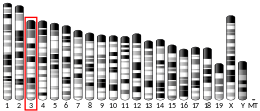BNIPL
Bcl-2/adenovirus E1B 19 kDa-interacting protein 2-like protein is a protein that in humans is encoded by the BNIPL gene.[5][6][7]
| BNIPL | |||||||||||||||||||||||||
|---|---|---|---|---|---|---|---|---|---|---|---|---|---|---|---|---|---|---|---|---|---|---|---|---|---|
| Identifiers | |||||||||||||||||||||||||
| Aliases | BNIPL, BNIP-S, BNIPL-1, BNIPL-2, BNIPL1, BNIPL2, BNIPS, PP753, BCL2/adenovirus E1B 19kD interacting protein like, BNIP-Salpha, BNIP-Sbeta, BCL2 interacting protein like | ||||||||||||||||||||||||
| External IDs | OMIM: 611275 MGI: 2384749 HomoloGene: 15900 GeneCards: BNIPL | ||||||||||||||||||||||||
| |||||||||||||||||||||||||
| |||||||||||||||||||||||||
| |||||||||||||||||||||||||
| Orthologs | |||||||||||||||||||||||||
| Species | Human | Mouse | |||||||||||||||||||||||
| Entrez | |||||||||||||||||||||||||
| Ensembl | |||||||||||||||||||||||||
| UniProt | |||||||||||||||||||||||||
| RefSeq (mRNA) | |||||||||||||||||||||||||
| RefSeq (protein) | |||||||||||||||||||||||||
| Location (UCSC) | Chr 1: 151.04 – 151.05 Mb | Chr 3: 95.24 – 95.25 Mb | |||||||||||||||||||||||
| PubMed search | [3] | [4] | |||||||||||||||||||||||
| Wikidata | |||||||||||||||||||||||||
| |||||||||||||||||||||||||
Interactions
BNIPL has been shown to interact with:
gollark: I'm still here, because I'm bored and don't have much else to do, but I can't actually talk right now, so meh.
gollark: https://www.youtube.com/channel/UChyGHWDo4efhnBolSCK0fwg
gollark: Apparently my meme library now contains 2809 memes, minus however many of them are random pictures in the same folder.
gollark: 😄 > that weird emoji thing
gollark: Idea: a bot to automatically update the topic whenever anyone says "is this [whatever]".
References
- GRCh38: Ensembl release 89: ENSG00000163141 - Ensembl, May 2017
- GRCm38: Ensembl release 89: ENSMUSG00000028115 - Ensembl, May 2017
- "Human PubMed Reference:". National Center for Biotechnology Information, U.S. National Library of Medicine.
- "Mouse PubMed Reference:". National Center for Biotechnology Information, U.S. National Library of Medicine.
- Shen L, Hu J, Lu H, Wu M, Qin W, Wan D, Li YY, Gu J (Apr 2003). "The apoptosis-associated protein BNIPL interacts with two cell proliferation-related proteins, MIF and GFER". FEBS Letters. 540 (1–3): 86–90. doi:10.1016/S0014-5793(03)00229-1. PMID 12681488.
- Zhou YT, Soh UJ, Shang X, Guy GR, Low BC (Mar 2002). "The BNIP-2 and Cdc42GAP homology/Sec14p-like domain of BNIP-Salpha is a novel apoptosis-inducing sequence". The Journal of Biological Chemistry. 277 (9): 7483–92. doi:10.1074/jbc.M109459200. PMID 11741952.
- "Entrez Gene: BNIPL BCL2/adenovirus E1B 19kD interacting protein like".
- Qin W, Hu J, Guo M, Xu J, Li J, Yao G, Zhou X, Jiang H, Zhang P, Shen L, Wan D, Gu J (Aug 2003). "BNIPL-2, a novel homologue of BNIP-2, interacts with Bcl-2 and Cdc42GAP in apoptosis". Biochemical and Biophysical Research Communications. 308 (2): 379–85. doi:10.1016/s0006-291x(03)01387-1. PMID 12901880.
- Yasuda M, Han JW, Dionne CA, Boyd JM, Chinnadurai G (Feb 1999). "BNIP3alpha: a human homolog of mitochondrial proapoptotic protein BNIP3". Cancer Research. 59 (3): 533–7. PMID 9973195.
External links
- Human BNIPL genome location and BNIPL gene details page in the UCSC Genome Browser.
Further reading
- Qin W, Hu J, Guo M, Xu J, Li J, Yao G, Zhou X, Jiang H, Zhang P, Shen L, Wan D, Gu J (Aug 2003). "BNIPL-2, a novel homologue of BNIP-2, interacts with Bcl-2 and Cdc42GAP in apoptosis". Biochemical and Biophysical Research Communications. 308 (2): 379–85. doi:10.1016/S0006-291X(03)01387-1. PMID 12901880.
- Xie L, Qin WX, He XH, Shu HQ, Yao GF, Wan DF, Gu JR (May 2004). "Differential gene expression in human hepatocellular carcinoma Hep3B cells induced by apoptosis-related gene BNIPL-2". World Journal of Gastroenterology. 10 (9): 1286–91. doi:10.3748/wjg.v10.i9.1286. PMC 4622767. PMID 15112343.
- Xie L, Qin WX, Li JJ, He XH, Shu HQ, Yao GF, Wan DF, Gu JR (Sep 2005). "cDNA expression array analysis of gene expression in human hepatocarcinoma Hep3B cells induced by BNIPL-1". Acta Biochimica et Biophysica Sinica. 37 (9): 618–24. doi:10.1111/j.1745-7270.2005.00086.x. PMID 16143817.
- Valencia CA, Cotten SW, Liu R (Dec 2007). "Cleavage of BNIP-2 and BNIP-XL by caspases". Biochemical and Biophysical Research Communications. 364 (3): 495–501. doi:10.1016/j.bbrc.2007.10.018. PMID 17961507.
This article is issued from Wikipedia. The text is licensed under Creative Commons - Attribution - Sharealike. Additional terms may apply for the media files.



